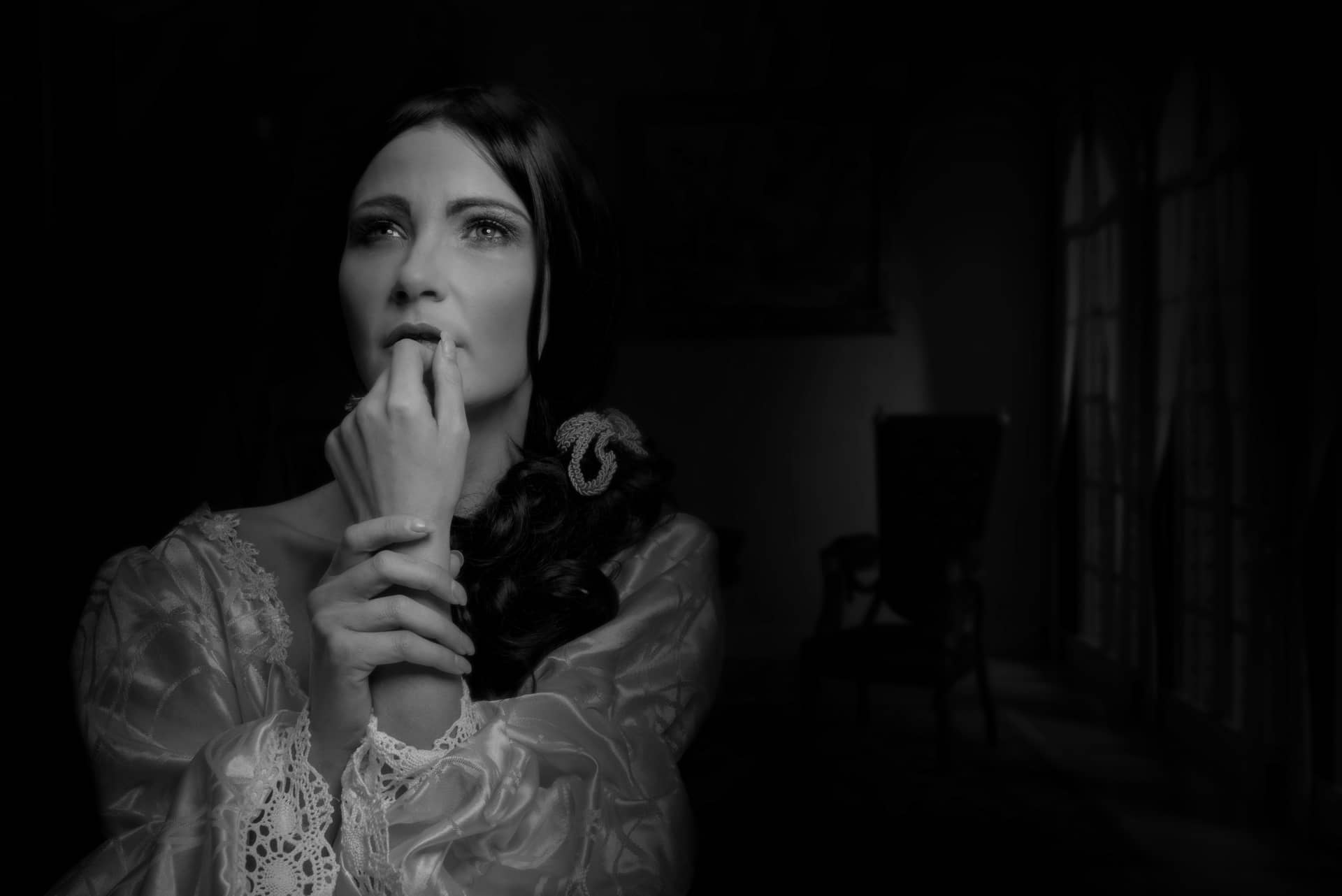One of the best things about being a book editor is spending time talking to folks about what they love to read, watch, and listen to. After all, since I’m trying to acquire projects that will resonate with readers, it makes sense to know what people enjoy, right? While most of my work days revolve around romance in all its forms, sometimes I get to dip my toes into different genres. Which is great, because my first love is horror. Since I was a kid, sneaking to the top of the stairs to catch a glimpse of the lizard people in V, or accidentally watching the most terrifying Disney film of all time (The Watcher in the Woods) and having a recurring nightmare for about six weeks, I’ve been fascinated by all things scary.
Some people may argue that romance and horror are far too different to be combined in the stories they love, but I disagree. Horror and romance are the perfect combination. Both genres require high stakes and very high emotion, and I think one is the flipside of the other: in romance, there absolutely must be a Happily Ever After (HEA) for the main characters; in horror, if protagonists end up happy, many folks would argue it’s not horror after all (see the discourse surrounding cozy horror that crops up every so often online). Nevertheless, the two genres work incredibly well together.
Before we can get into all the gory, gruesome horror, we need to have a conversation about the romance. As I’ve said, romance and horror may seem like they don’t create a complementary genre mash up at first glance, but I think they can absolutely work together to create interesting, nuanced, emotionally fraught stories. We just have to adjust our definitions of each genre slightly to properly appreciate horror romance. And the biggest challenge for horror romance is something called the HEA.
The expectation, especially in romance fiction, is that the main romantic couple (or grouping, as the case may be) must end up happy and together in a relationship at the end of the story—HEA. This rule is a bit less strict in films, and many extremely romantic films, from Casablanca to In the Mood For Love to Eternal Sunshine of the Spotless Mind, end in a tragedy of some sort. So what is it about a romance that makes it a romance? As a genre, romance is more of an emotional qualifier than a specific set of plot points or a setting that needs to be present to be considered part of the genre.
You can’t have a historical costume drama that takes place in the present day—it needs a setting that is, well, historical. Likewise, it’s difficult to call your film a western if it doesn’t take place in a new frontier of some kind, though it doesn’t necessarily have to be the American West. In a genre like romance, there are many subgenres that all fit under the wider umbrella of capital R romance because the underlying emotional journeys of the characters is similar no matter the setting or the time—they’re always moving toward a HEA. Films like A Room with a View, Down with Love, and Crazy Rich Asians couldn’t be more different in their execution, settings, and time periods, yet they remain romances with happily ever after endings.
Often, romance in horror films serves as a code for exploring more taboo subjects that were frowned upon by mainstream audiences. Early horror films like Island of Lost Souls tempt our hero away from traditional, chaste monogamy with wild, uninhibited, animal women. As the studio system falls in the late 1960s, horror films begin exploring more progressive sexual politics, with romance tropes and characters standing in for queerness. Monster romances ask audiences to grapple with the idea of xenophobia: we’re all just looking for companionship, no matter if we’re White, Black, or Gill-Men. Romance is sometimes the transgressive catalyst that pushes the film further into the horror genre; a movie like Hellraiser uses a torrid affair between Julia and her husband’s brother Frank as shorthand to give the audience a more layered character. Frank’s search for hedonistic pleasures doesn’t end in death, and Julia is eager to seemingly continue her relationship, adding grotesque nuance to a horror film that blew me away when I first saw it.
Romance in horror is often a stand in for something else. It’s about characters looking for acceptance and stability in the face of terrifying, sometimes deadly circumstances. Or maybe instead of a repulsion of the darkness surrounding them, it can be an attraction to the darkness, wanting to join the monster or let the monster inside of them out. Take someone like Sarah, Susan Sarandon’s character in The Hunger. Sarah gravitates toward Catherine Deneuve’s Miriam not only because she is attractive and welcoming, though that is certainly the case. But Sarah is also drawn to the darkness in Miriam, much as she tries to resist initially. That darkness is a stand in for power, for sexuality and the freedom that comes from being uninhibited. The romance here is a way for the audience to feel, to interact with the story on a deeper level than a typical vampire story (though I could argue that most, if not all, vampire films contain at least a hint of romance).
One of the other reasons horror and romance are so complementary, especially on film, is that they’re, well, wet. The two genres thrive in depictions of the body: lips bitten in anticipation, breaths catching in lust or in fear, hearts pierced with an arrow, whether from Cupid or Jason Voorhees. To fully understand both genres, I think you need to embrace the visceral, though not necessarily by spraying viscera all over the place (there’s still room for slow burns and atmosphere over outright violence). The flesh, whether it’s being adored or mutilated, plays an incredibly important role in both horror and romance. The most successful films in the genre understand that the emotions that are evoked need to be reflected on screen through the characters’ physical reactions. Audiences want to be aroused or disgusted (or maybe both?) while they’re watching these films, and the really memorable romantic horror films are full of bodily fluids, either on screen or implied, delivering equal parts dread and excitement.
Many of the most successful horror romance films luxuriate in the physical over the intellectual. The emotions of fear and lust are not clinical and detached—they’re reactionary, reflexive. A film like Don’t Look Now doesn’t work the same way if you watch it hoping to explain the mystery. But if you let him, director Nicolas Roeg will transport you into a heartbreaking, sexy, and incredibly tender story about grief, marriage, and killer dwarves. The romantic tension in Don’t Look Now is heightened by the uncertainty and fear the characters face, and vice versa. Will Donald Sutherland and Julie Christie stay together after the tragedy they face? Will the premonitions and supernatural happenings keep the two from a happily ever after?
David Cronenberg’s The Fly is a masterclass in wedding the joys of the flesh with the horrors. Jeff Goldblum’s brilliant scientist Seth and Geena Davis’s talented journalist Ronnie give into physical pleasure when they embark on their relationship, only to be undone by the stomach-churning decay of Seth’s gruesome transformation into a human/fly monster. The initial romantic journey of the characters is heightened and complemented by the horror here, and the emotional connection of the couple only deepens the awful sinking feeling as the audience realizes there’s no saving Seth.
While there are of course overlaps between other genres, horror romance feels like a balance that can be tricky to achieve. It’s easy to add a horror or a romance element to another genre, from science fiction to noir to western. But while many genre films and stories rely on conventional or trope-driven plot points, both horror and romance focus on the emotional journey. The way a character feels dictates whether it’s a horror or romance story, whereas in many genre stories, it’s how a character acts that determines the kind of story they’re in. And since the emotional endpoint for horror is often the polar opposite to romance, a satisfying horror romance must look at genre in a slightly different way. At the end of Bram Stoker’s Dracula, Vlad gets a happy ending of sorts, finally resting after searching for the love of his life across oceans. But Mina doesn’t ride off into the sunset with him, much as part of her is drawn to his dangerous, monstrous character.
Unlike some other speculative genres, horror is a similar emotion-forward kind of storytelling. You can inject horror into any number of other genres, from western to sci-fi to historical costume drama, just as you can add a romantic flavor to almost any kind of story. The feelings and the emotional journey of characters in horror often runs counter to those in romance. Instead of an emotionally satisfying conclusion where the characters come together in a HEA, characters in a horror film often start out in a place of relative comfort and safety and become unmoored, thrust into violence and terror. Even in a very straightforward slasher film, the Final Girl is arguably transformed by the end of the movie, forever traumatized by the death she’s witnessed. Horror is not comfortable; it’s the opposite of comfortable, which certainly puts it at odds with romance.
So horror moves from comfort to tension, and romance moves from tension to comfort. How do you put these two together in a satisfying way? It’s not necessarily about equality. Think about it—if a movie was fully committed to both horror and romance for its full running time, audiences would probably struggle, because there wouldn’t be any room to alleviate the tension that stayed high throughout the film. You’d go from will they or won’t they kiss to will they or won’t they survive with no break, and chances are, you’d end up with a jumbled mess of disparate tones and scenes. Instead, successful romance elements in horror films are used more sparingly. Maybe the film begins with a sweet romance that is torn apart in spectacular fashion, like in David Cronenberg’s remake of The Fly. Or perhaps two people find themselves and each other in the midst of a traumatic and horrifying situation, a la Zombieland.
Too much of a happy ending completely undermines the horror, so the audience needs to be satisfied with a different kind of happy ending; the characters must be fundamentally changed by their experience, whether that means they’re traumatized, literally transformed into a monstrous creature, or perhaps even end up dead. The most effective films blend the two genres into something slightly different, or instead begin as one genre and transform into something more.
In horror romance, this is usually the time where things start to go really wrong. But as you’ll see, that doesn’t always mean there won’t be a HEA—it might look a little different from a typical fairytale ending, but sometimes love prevails even when lives don’t.
I’m still on the lookout for a perfect horror romance novel (Twin Peaks romance, anyone?), so for now films will have to do. I’m glad there are so many wonderful ones to choose from, and that just as horror and romance have evolved separately, horror romance films have found ways to combine the two genres into something both scary and full of heart. Sometimes, though, the hearts are on the outside.

